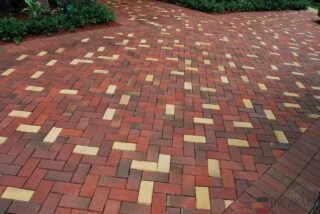
Our ExpertiseFind On This Page The Pavers Services We Provide In The Counties Of Broward, Palm Beach, And Miami-Dade. Give us a shot!
We distribute and install a wide selection of Brick Pavers, Travertine, Marble, Granite, Basalt, and Pour Concrete to any kind of residential and commercial area, such as Driveways, Pool Decks, Patios, Backyards, Porches, or Walkways.
Materials can be customized to please your design preference. We take care of the whole process, including the preparation and installation of the turnkey project. Everything is covered, from the stage of demolishing and preparation, to the installation, compaction, and final touches.
We have an amazing team of experts, who will make any project a very pleasant experience. Our office is located in Broward County at Southwest Ranches FL. We also operate around Palm Beach and Miami Dade county.
Image Gallery






























































History of Pavers
The history of pavers for homes is a fascinating journey that spans several centuries. Pavers have played a crucial role in enhancing the aesthetics and functionality of outdoor spaces. Here’s an overview of their history:
Ancient Times: The use of pavers can be traced back to ancient civilizations such as the Romans, Greeks, and Egyptians. These cultures utilized natural stone and clay bricks to create paved surfaces for roads, pathways, and plazas. The Romans, in particular, are renowned for their advanced road-building techniques and intricate mosaic patterns.
Middle Ages: During the Middle Ages, paver technology saw limited advancement due to the decline of infrastructure development. However, monasteries and castles often featured paved courtyards and walkways using rough-hewn stone or bricks.
Renaissance and Baroque Eras: As Europe emerged from the Middle Ages, there was a renewed interest in architecture and urban planning. Paved plazas and streets became more common, and decorative patterns using various types of stones gained popularity.
Industrial Revolution: The 18th and 19th centuries marked significant advancements in construction materials and techniques. Machine-made bricks and concrete blocks started to replace natural stone, making pavers more accessible and affordable for a wider range of applications.
Early 20th Century: The introduction of the automobile led to increased demand for durable and functional road surfaces. Concrete and asphalt became the primary materials for road construction, but decorative pavers still found use in sidewalks, driveways, and garden paths.
Mid-20th Century: Interlocking concrete pavers, as we recognize them today, were first developed in the Netherlands in the 1940s. These pavers featured a unique design that allowed them to interlock with neighboring units, providing greater stability and load-bearing capacity.
Late 20th Century: Interlocking concrete pavers gained popularity in North America during the latter half of the 20th century. Their versatility, durability, and aesthetic appeal made them a preferred choice for various residential and commercial applications.
Contemporary Times: Modern pavers come in a wide array of materials, colors, shapes, and sizes, allowing for endless design possibilities. They are commonly used for driveways, patios, walkways, pool decks, and other outdoor spaces. Advancements in manufacturing technology have led to the development of permeable pavers, which help manage stormwater runoff and promote eco-friendly landscaping.
Throughout history, pavers have evolved from simple stone slabs to intricate and durable interlocking units, playing a vital role in landscaping and outdoor design. They continue to be a staple in the construction industry, enhancing the beauty and functionality of homes and outdoor spaces around the world.
Types of Pavers
Pavers come in various materials and styles, but here are four of the most common types of pavers used for homes:
- Concrete Pavers: Concrete pavers are a popular choice due to their durability, versatility, and cost-effectiveness. They come in a wide range of shapes, sizes, and colors, making them suitable for various landscaping styles. Concrete pavers can mimic the appearance of natural stone or be stamped with patterns for a decorative look.
- Brick Pavers: Brick pavers are classic and timeless, providing a traditional and charming look to outdoor spaces. They are made from fired clay and are available in different shades and sizes. Brick pavers are durable and can withstand heavy foot traffic, making them suitable for driveways, walkways, and patios.
- Natural Stone Pavers: Natural stone pavers, such as limestone, granite, slate, and bluestone, offer a high-end and elegant appearance. They are known for their unique textures, colors, and natural variations. Natural stone pavers are typically more expensive than other options but can create stunning and durable surfaces.
- Interlocking Pavers: Interlocking concrete pavers are designed with a unique system that allows them to fit together like puzzle pieces. This design provides stability and flexibility, making them resistant to cracking and shifting. Interlocking pavers are often used for driveways, patios, and walkways.
Remember, the choice of pavers depends on factors such as budget, desired aesthetic, the intended use of the area, and the local climate conditions. Each type of paver has its own set of benefits and considerations, so it’s important to discuss these factors with your clients before making a decision.









